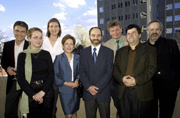
(click to enlarge)
On the balcony of the Samuel Bronfman Building, left to right, Benoît
Bolduc, Lyse Roy, Hélène Visentin, Marie-France Wagner,
Provost and Vice-Rector Research Jack Lightstone, Pierre-Louis Vaillancourt,
Daniel Vaillancourt and Alain Laframboise.
Photo by Andrew Dobrowolskyj
|
by Barbara Black
The recipients of one of the largest research grants in the humanities
ever awarded to Concordia held a reception April 19 to celebrate the launch
of their project.
GRES stands for Groupe de recherche sur les entrées solennelles
au 16e siècle, and will study the evolution of royal processions
in French towns between 1484 and 1615. The full name of the project is
Le spectacle du pouvoir : les entrées solennelles des rois dans
les villes françaises au XVIe siècle.
Professor Marie-France Wagner, of Concordia’s Département
des Études françaises, is the principal investigator in
the project, which has received a $1.6-million grant over five years from
the Social Sciences and Humanities Research Council of Canada (SSHRC).
The collaborators are:
Benoît Bolduc, professor of literature in the French department
of the University of Toronto, who will focus on the theatrical aspect,
notably theories of representation, poetry and rhetoric.
Lyse Roy, professor of modern European history at the Université
du Québec à Montréal (UQAM), who specializes in the
inter-relations between the universities and cities of 16th-century France.
Hélène Visentin, professor of French literature at Smith
College, U.S.A., who studies various aspects of theatre.
Marie-France Wagner, Concordia, who has been studying royal processions,
the “theatricization” of the city, symbols of royal power, and
social representations.
Pierre-Louis Vaillancourt, professor of literature in the French department
of the Université d’Ottawa, who specializes in European political
thought and is interested in the power relationships of social groups.
Daniel Vaillancourt, professor of literature in the French department
of the University of Western Ontario, who has worked for several years
on the intellectual conditions surrounding the urban centres of the 17th
century.
Alain Laframboise, professor of art history at the Université de
Montréal, who studies the links between art and theatre, particularly
the evolution of urban festivals. He specializes in the Italian Renaissance.
GRES has a number of other scholars, as well, including two post-doctoral
candidates, Louise Frappier (Concordia) and Alexander Nassichuk (Western),
five doctoral students (one from Concordia, two from UQAM and two from
Toronto), and eight master’s students (three from Concordia, four
from UQAM and one from U de M).
In the course of the project, Marie-France Wagner and her colleagues will
also collaborate with the Université de Paris X-Nanterre, the Université
François-Rabelais de Tours, the University of Pittsburgh, UQAM
and the Office of the Secretary to the Governor-General of Canada (Heraldry
Directorate).
Lest anyone think that 16th-century French kings are an irrelevant topic,
master’s student Audrey Nanot was quick to point out in a conversation
at the reception that the display of state power in public never loses
its allure.
Nanot, who grew up in France, plans to do her thesis on modern journalism
and its coverage of politicians. She pointed out that only last week,
in the course of the French presidential election campaign, prime minister
Lionel Jospin was spattered with ketchup. The incident will go right into
her research.
|
| |




